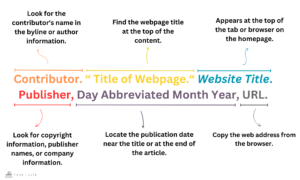How to Cite a Webpage in the MLA Format
- Tomas Elliott (Ph.D.)
- Published on 11/13/2023
- Updated on01/13/2024
Creating a comprehensive and standardized MLA citation for webpages involves integrating specific elements. Here is a quick guide that encompasses these key aspects.
An MLA webpage citation typically comprises:
- Author’s Name: If the author of the webpage is known, their name begins the citation. It’s typically written in the format of last name, first name. However, if the author is unknown, the citation starts with the title of the page or article.
- Page Title (in Quotation Marks): The title of the specific page or article within the larger website is enclosed in quotation marks. This distinguishes the individual content from the overall website.
- Website Name (in Italics): After the page title, the name of the website is italicized. This indicates the larger source or platform where the specific content is hosted. It helps readers identify the broader context of the information.
- Publication Date: The publication date is presented in the format of Day Abbreviated Month Year. For instance, 21 Sep. 2023. This date is crucial for referencing the specific version of the page or article you accessed. If the publication date is missing or the content is likely to change, including an access date at the end is recommended.
- URL: The citation concludes with the URL, the direct web address where the content can be accessed. It’s listed without the “https://” part, allowing readers to easily access the online source.

WEBPAGE WITH AN INDIVIDUAL AUTHOR
When the webpage has an individual author, begin the citation with the author’s name, include the last name first, followed by the first name. Following the author’s name, enclose the title of the page or article in quotation marks. After the page title, add the name of the website in italics. Next, include the publication date in the format of Day Month Year. Conclude the citation with the URL, which allows readers to directly access the source online. Ensure that the URL is provided without the “https://” part.
| Citation |
Liao, Christina. “Kabuki and Noh are Evolving With the Times.” National Geographic, 10 Nov. 2023, www.nationalgeographic.com/travel/japanese-theater-noh-kabuki.
|
| Structure |
Author Last Name, First Name. “Title of Webpage.” Website Title, Publisher, Day Abbreviated Month Year, URL.
|
 |
For citing articles from online newspapers, magazines, or blogs, the format aligns with general webpage citations. However, if the article is a PDF of a print article, minor adjustments are made, including the use of the most recent publication date available. Abbreviate all months longer than four letters. For instance, January becomes Jan, February becomes Feb, and so on. Do not abbreviate the months of May, June, and July. Include the publisher’s name when available. This applies particularly to web sources or articles where the publisher’s name is different from the website’s title. |
WEBPAGE WITH A GROUP AUTHOR
When citing a webpage where a group or organization is credited as the author, the approach in MLA formatting varies slightly. Start the citation with the name of the group or corporation, then follow the same formatting structure used for an individual author above.
| Citation |
G20 Global Smart Cities Alliance. “Using Data for Social Impact.” World Economic Forum, 10 Nov. 2023, www.weforum.org/press/2023/11/using-data-for-social-impact/.
|
| Structure |
Group/Corporate Author(s). “Title of Webpage.” Website Title, Day Abbreviated Month Year, URL.
|
GROUP AUTHOR SAME AS WEBSITE TITLE OR NO AUTHOR
If the group or corporate author shares the same name as the website title or if there is no credited author, start the citation with the title of the webpage. Enclose the title in quotation marks to specify it as an individual article or page within the larger website.
| Citation |
“Kamala Harris v Mike Pence: Why this vice-president debate matters.” BBC News, 8 Oct. 2020, www.bbc.com/news/election-us-2020-54423497.
|
| Structure |
“Title of Webpage.” Website Title, Day Abbreviated Month Year, URL.
|
CITING WEBPAGES WITH NO DATE
For webpages without a publication date, it’s essential to include an access date at the end of citation to indicate when you accessed the content.
| Citation |
Dosey, Ted. “How to Become a Quick Learner.” Wikihow, www.wikihow.com/become-a-quick-learner. Accessed 10 Nov. 2023.
|
| Structure |
Author Last Name, First Name. “Title of Webpage.” Website Title, URL. Accessed Day Abbreviated Month Year.
|
Explore a range of features offered by TypeCite’s citation generator, including MLA citation for books, webpages and journals, as well as APA citation for books.
GIVE YOUR CITATIONS A BOOST TODAY
Start your TypeCite Boost 3 day free trial today. Then just $4.99 per month to save your citations, organize in projects, and much more.
SIGN UP